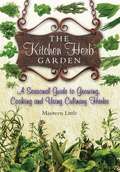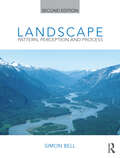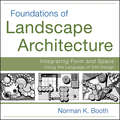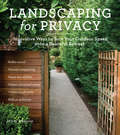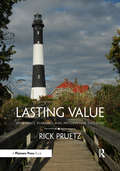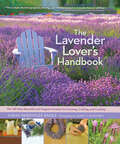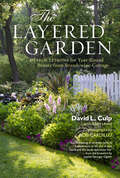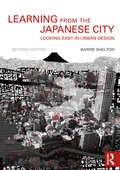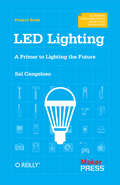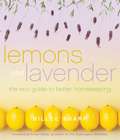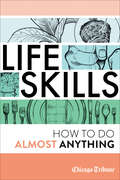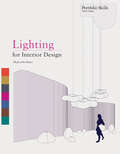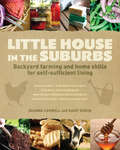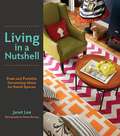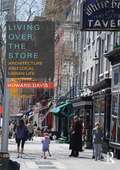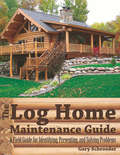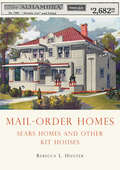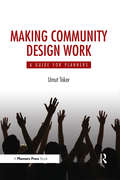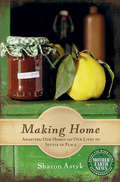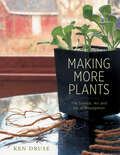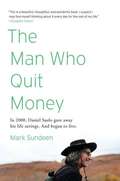- Table View
- List View
The Kitchen Herb Garden: A Seasonal Guide To Growing, Cooking And Using Culinary Herbs
by Maureen LittleThis book is full of inspiration and practical advice on cultivating a kitchen herb garden,and on using its fresh,home-grown herbs in your cooking. There is detailed information on how to plan,plant,grow and maintain thirty selected herbs in a herb garden that will always be productive.Additionally,there are over sixty delicious recipes - from soups to sauces - for using herbs in your kitchen.The book includes information on:Which culinary herbs to plant,and how to grow them. Illustrated planting plans for designing different types of herb garden. Using herbs to flavour oils, vinegars, butters,sugars and jellies. How to harvest,dry and preserve your herbs How to grow herbs in containers. How to match herbs to ingredients in your cooking.
Landscape: Pattern, Perception and Process
by Simon BellLandscapes develop and evolve through an interacting series of processes – climatic, geological, ecological and cultural – over varying periods of time. These processes shape the structure and character of the landscapes which we experience. Over time, distinctive patterns emerge – ranging in scale from the distribution of small plants to the sculptured sides of a huge canyon. Our perception of these patterns goes beyond just their visual appreciation – beautiful though they may be – into a richer understanding of how we experience our environment. By understanding this complex pattern–process interaction we can obtain a deeper awareness of landscape and our place in it – as inhabitants and as shapers. The book explores the nature of patterns and ways of classifying them before studying the nature of perception (primarily visual but including other senses), then proceeds to relate this perception to aesthetics and from there to the design process. From this point the main driving processes in landscape are introduced alongside the resulting patterns, these being climatic, landform, ecosystem and cultural aspects. It is this integrative approach of looking at landscape as a kind of self-organising system, overlaid by conscious human planning activities and the unity of pattern and process, which makes this book unique. Landscape draws from a wide range of neighbouring disciplines, of which the landscape planner or designer needs to be aware, but which are often taught as distinct elements. Bell binds these fundamentals together, which enables the landscape to be ‘read’, and this reading to be used as the basis for planning and design. This second edition updates and refreshes the original material with added sections and new photos, particularly making use of the developments in satellite photography. Featuring full colour throughout, this textbook is ideal for anyone studying landscape architecture or any of the disciplines which intersect with the landscape, and which affect it.
Landscape Architecture
by Norman K. BoothA visually engaging introduction to landscape architectural design Landscape architectural design seeks to create environments that accommodate users' varying lifestyles and needs, incorporate cultural heritage, promote sustainability, and integrate functional requirements for optimal enjoyment. Foundations of Landscape Architecture introduces the foundational concepts needed to effectively integrate space and form in landscape design. With over five hundred hand-rendered and digital drawings, as well as photographs, Foundations of Landscape Architecture illustrates the importance of spatial language. It introduces concepts, typologies, and rudimentary principles of form and space. Including designs for projects such as parks, campuses, and memorials, this text provides the core concepts necessary for designers to shape functional landscapes. Additionally, chapters discuss organizational and spatial design structures based on orthogonal forms, angular forms, and circular forms. Helping students, professionals, and lifelong learners alike, Foundations of Landscape Arch-itecture delivers a concrete understanding of landscape architectural design to inspire one's imagination for countless types of projects.
Landscaping for Privacy: Innovative Ways to Turn Your Outdoor Space into a Peaceful Retreat
by Marty WingateThe area around your home is your haven, your sanctuary, your refuge from the noise and irritation of traffic, eyesores, and nosy neighbors. Or at least it could be if there was some sort of barrier between your front yard and the sidewalk, or if you didn't have to stare at the back of the neighbors' garage when you want to relax on your patio. Landscaping for Privacy brims with creative ideas for minimizing or even eliminating the nuisances that intrude on your personal outdoor space. Scores of real-world examples show you how to keep the outside world at bay by strategically placing buffers (such as berms or groups of small trees), barriers (such as fences), and screens (arbors or hedges, for example) around your property. And the helpful plant lists tell you precisely which varieties to choose in order to enhance your sense of seclusion. If you've ever felt frustrated by the lack of privacy whenever you step outside your home, this inspiring book will steer you toward an achievable solution.
Lasting Value: Open Space Planning and Preservation Successes
by Rick PruetzAmericans are committing 'country-cide', says Rick Pruetz, FAICP, converting farms into suburban yards and channeling streams that once provided flood control, water purification, habitats, and recreational opportunities. But rather than rail against overdevelopment, this book celebrates communities succeeding in preservation. For ten years Pruetz explored communities that excel in saving their natural environment. In twenty-four illustrated vignettes, he captures the character of places from the volcanic range near downtown Albuquerque, New Mexico, to Minneapolis’s Grand Rounds park system, to farmland improbably preserved on Long Island. As the longtime city planner of Burbank, California, Pruetz offers more than an appreciation of these communities. He brings a planner’s-eye view of the practices behind their achievements. His detailed reports of creative preservation solutions mark the trail for planners, commissioners, and citizens who seek to preserve the green legacy in their own backyards.
The Lavender Lover's Handbook: The 100 Most Beautiful and Fragrant Varieties for Growing, Crafting, and Cooking
by Sarah Berringer Bader Janet Loughrey“I think it pisses God off when you walk by the color purple in a field somewhere and don’t notice it.” —Alice WalkerThe Lavender Lover's Handbook provides a complete checklist of the color, fragrance, size, and foliage of the 100 easiest, most stunning lavenders available today. In addition to details about spacing, planting, pruning, Sarah Berringer Bader offers tips to harvest, cook, and craft with this wonderful herb. The abundant variety, hardiness, fragrance, and culinary opportunities make lavender one of the most popular and versatile plants, and with this practical and accessible guide, it's easier than ever to grow lush lavender at home.
The Layered Garden: Design Lessons for Year-Round Beauty from Brandywine Cottage
by Rob Cardillo David L. Culp Adam Levine“Gardenmaking, in its finest form, is a celebration of life and of love. David and his book epitomize this.” —Lauren Springer Ogden Brandywine Cottage is David Culp's beloved two-acre Pennsylvania garden where he mastered the design technique of layering—interplanting many different species in the same area so that as one plant passes its peak, another takes over. The result is a nonstop parade of color that begins with a tapestry of heirloom daffodils and hellebores in spring and ends with a jewel-like blend of Asian wildflowers at the onset of winter.The Layered Garden shows you how to recreate Culp's majestic display. It starts with a basic lesson in layering—how to choose the correct plants by understanding how they grow and change throughout the seasons, how to design a layered garden, and how to maintain it. To illustrate how layering works, Culp takes you on a personal tour through each part of his celebrated garden: the woodland garden, the perennial border, the kitchen garden, the shrubbery, and the walled garden. The book culminates with a chapter dedicated to signature plants for all four seasons.
Learning from the Japanese City: Looking East in Urban Design (Planning, History and Environment Series)
by Barrie SheltonJapanese cities are amongst the most intriguing and confounding anywhere. Their structures, patterns of building and broader visual characteristics defy conventional urban design theories, and the book explores why this is so. Like its cities, Japan’s written language is recognized as one of the most complicated, and the book is unique in revealing how the two are closely related. Set perceptively against a sweep of ideas drawn from history, geography, science, cultural and design theory, Learning from the Japanese City is a highly original exploration of contemporary urbanism that crosses disciplines, scales, time and space. This is a thoroughly revised and much extended version of a book that drew extensive praise in its first edition. Most parts have stood the test of time and remain. A few are replaced or removed; about a hundred figures appear for the first time. Most important is an entirely new (sixth) section. This brings together many of the urban characteristics, otherwise encountered in fragments through the book, in one walkable district of what is arguably Japan’s most convenient metropolis, Nagoya. The interplay between culture, built form and cities remains at the heart of this highly readable book, while a change in subtitle to Looking East in Urban Design reflects increased emphasis on real places and design implications.
LED Lighting
by Sal CangelosoWe're on the brink of a lighting revolution with light-emitting diodes--the tiny LEDs you've seen in electronic devices for years. With this practical guide, you'll go behind the scenes to see how and why manufacturers are now designing LED devices to light everything from homes and offices to streets and warehouses. Author Sal Cangeloso shows you the working parts of a "simple" LED bulb and explains the challenges electronics companies face as they push LED lighting into the mainstream. You'll learn how you can use LEDs now, and why solid state lighting will bring dramatic changes in the near future. Explore the drivers, phosphors, and integrated circuits in a typical LED bulb Understand the challenges in producing LED bulbs with acceptable brightness, color temperature, and power consumption Learn about non-bulb LED applications, including lamps, street lights, and signage Discover the market forces driving--and impeding--the adoption of LED lighting Compare LEDs to compact fluorescent lamps (CFLs) and electron-stimulated luminescence (ESL) bulbs Gaze into the future of intelligent lighting, including networked lighting systems
Lemons and Lavender: The Eco Guide to Better Homekeeping
by Billee SharpAuthor Billee Sharp shares her freecycling, budget-savvy, barter-better wisdom in this step-by-step handbook for revolutionizing spending habits and reclaiming quality of life. Lemons and Lavender is an inspiring and instructive guide to living the handmade life by consuming less and creating more. Practical and profound, this handy how-to covers every area of life and offers easy-to-do tips, recipes, and advice for saving money and the planet. Learn how to ditch your lawn and raise organic vegetables, cook healthy meals for pennies, cure minor maladies from the kitchen cabinet, save big dollars with small repairs, and eco-clean your house with lemons and lavender. With this guide, families can live more joyfully and far more creatively, all on a dime.
Lemons and Lavender
by Billee Sharp Anneli RufusAuthor Billee Sharp shares her freecycling, budget-savvy, barter-better wisdom in this step-by-step handbook for revolutionizing spending habits and reclaiming quality of life. Lemons and Lavender is an inspiring and instructive guide to living the handmade life by consuming less and creating more. Practical and profound, this handy how-to covers every area of life and offers easy-to-do tips, recipes, and advice for saving money and the planet. Learn how to ditch your lawn and raise organic vegetables, cook healthy meals for pennies, cure minor maladies from the kitchen cabinet, save big dollars with small repairs, and eco-clean your house with lemons and lavender. With this guide, families can live more joyfully and far more creatively, all on a dime.
Life Skills: How to Do Almost Anything
by Chicago TribuneAn entertaining treasury of tips, hacks, and step-by-step techniques to smooth your way through the world.How do you give a good wedding toast? How do you fix a clogged drain? How do you bowl without hurting anyone? Questions like these—some highly practical, others wildly funny—make up this engaging do-it-yourself guide. Including illustrations and diagrams and compiled from the Chicago Tribune how-to column “Life Skills,” this book is filled with often-humorous instructions on performing a variety of tasks—from technical challenges to social interactions.sew a button • wrap a gift • shine your shoes • clean your keyboard • ask for a raise • give yourself a facial massage • flirt • pack for a road trip • turn down a request • teach someone to ride a bike • photograph a dog • change a tire • fix a faucet • load a moving truck • end a relationship • give a tip • choose an engagement ring • and more
Lighting Design Basics
by Mark Karlen James R. Benya Christina SpanglerThe essential book of lighting for professional designers, now updated and revisedProviding the fundamental information new designers need to succeed in a concise, highly visual format, the Second Edition of Lighting Design Basics presents realistic goals that can be used as a guide to create simple yet impressive lighting designs and when collaborating with professional designers on more complex projects.Drawing on real-world case studies-- from kitchens to doctors' offices--the book is packed with attractive, helpful illustrations, making it an invaluable resource for students, as well as interior designers and architects studying for professional licensing exams.Authored by leading lighting designers with decades of experience Offers straightforward coverage of lighting concepts and techniques Contains design scenarios for more than twenty different types of spaces Lighting is a basic, yet difficult-to-master element of interior design. Lightning Design Basics changes that, putting the power to create in the hands of the designer.
Lighting for Interior Design (Portfolio Skills Ser.)
by Malcolm InnesWithout light, interior architecture cannot be fully designed and experienced. It is one of the key tools for an interior designer, but can be a dauntingly technical subject for students.Part One, Theory, looks at the physics and technology behind lighting. Part Two, Process and Practice, looks more specifically at the use of lighting in interior design and outlines the key design issues and principles. The book goes on to show the ways of representing lighting schemes using CAD and 3D models and how to implement and test these designs. Finally, the book explains how to deal with contractors, clients and other professionals.This book takes a detailed, practical look at lighting in interior design, giving students all the key information and skills they need to be able to tackle lighting successfully in their designs.
Lighting for Interior Design (Portfolio Skills)
by Malcolm InnesWithout light, interior architecture cannot be fully designed and experienced. It is one of the key tools for an interior designer, but can be a dauntingly technical subject for students.Part One, Theory, looks at the physics and technology behind lighting. Part Two, Process and Practice, looks more specifically at the use of lighting in interior design and outlines the key design issues and principles. The book goes on to show the ways of representing lighting schemes using CAD and 3D models and how to implement and test these designs. Finally, the book explains how to deal with contractors, clients and other professionals.This book takes a detailed, practical look at lighting in interior design, giving students all the key information and skills they need to be able to tackle lighting successfully in their designs.
Little House in the Suburbs: Backyard farming and home skills for self-sufficient living
by Deanna Caswell Daisy SiskinsSelf-Sufficiency in the Suburbs!Gardens, goats and chickens in the suburbs? Absolutely!The easy-to-follow advice in this book will show you everything you need to know to enjoy an abundant, independent life on food and products grown in your own back yard. You may feel like you have superpowers the first time you prepare a meal using only ingredients you grew in your garden. And is there anything you can't do after you lather up with a bar of soap that you made in your own home? This book is full of recipes and tips that will help you discover the joy of self-sufficiency. Do''t worry; suburban gardening doesn't mean you have to rip up your yard, or risk being ostracized by neighbors or your municipality or homeowners association.Inside you'll find:Gardening instructions for any-size yard and any skill levelA complete overview of keeping chickens, mini-goats and bees in the suburbsMore than 40 food recipes featuring ingredients from your garden or animalsCanning techniquesRecipes for natural deodorant, toothpaste, lip balm and other beauty products Step-by-step soapmaking instructions and soap recipesNatural cleaning recipes for kitchens, bathrooms, surfaces and laundryGift basket ideasCommunity-building ideas including babysitting co-ops, meal swaps, and barter systemsAdvice on how to keep the peace with family, neighbors, and officials if your self-sufficient plans meet resistance
Living in a Nutshell
by Janet LeeA fireplace on wheels? A chandelier light by Xerox? A shrink-wrapped designer closet? These are just a few of the more than one hundred innovative projects in Living in a Nutshell, a DIY guide of decorating ideas that fool the eye into seeing and believing a little lair is larger and more glamorous than its four walls. Here are fresh ideas for enhancing every living area of a tiny space. All are simple, affordable, portable, and big on style. An illustrated survival tool kit as well as extensive listings of untapped, off-the-beaten-track design resources and a select buying guide round out this invaluable book.
Living Over the Store: Architecture and Local Urban Life
by Howard DavisThe shop/house – the building combining commercial/retail uses and dwellings – appears over many periods of history in most cities in the world. This book combines architectural history, cross-cultural understandings and accounts of contemporary policy and building practice to provide a comprehensive account of this common but overlooked building. The merchant's house in northern European cities, the Asian shophouse, the apartment building on New York avenues, typical apartment buildings in Rome and in Paris – this variety of shop/houses along with the commonality of attributes that form them, mean that the hybrid phenomenon is as much a social and economic one as it is an architectural one. Professionals, city officials and developers are taking a new look at buildings that allow for higher densities and mixed-use. Describing exemplary contemporary projects and issues pertaining to their implementation as well as the background, cultural variety and urban attributes, this book will benefit designers dealing with mixed-use buildings as well as academics and students.
The Log Home Maintenance Guide: A Field Guide for Identifying, Preventing, and Solving Problems
by Gary SchroederPreventing problems and dealing with them when they occur. America has hundreds of thousands of log homes, and every one of them presents unique maintenance issues that differ from homes of traditional stick-frame construction. Lack of knowledge about the unique characteristics of a log home all too often results in owners inadvertently doing damage when they try to make repairs. Owners of log homes have long relied on the expertise of log home builder and specialist Gary Schroeder and his Schroeder Log Home Supply company, a trusted source of information and guidance. From dry rot to carpenter ants, Schroeder has seen it all. Now he shares his wisdom on how to preserve and protect your beautiful log home. This newly revised edition takes advantage of all the recent techniques and products--it's a state-of-the-art guide to identifying, diagnosing, and solving problems so you'll enjoy many trouble-free years in your log home. Gary Schroeder, a former forester and consultant, has also been a custom log home builder and restoration contractor. He and his wife, Kathy, started Schroeder Log Home Supply, Inc., now a leader in the field, in 1986.
Mail-Order Homes
by Rebecca HunterAt the turn of the last century, the American middle class was expanding rapidly as homesteaders moved west and as trains took travellers across the country, where they established themselves in the depot towns that erupted along train lines. With that growth came the demand for new homes, and from that demand grew a new industry: mail-order homes. Sold by such makers as Sears, Roebuck & Co., Aladdin, and Montgomery Wards, these kit homes were shipped by train, arriving in two boxcars, which then were off-loaded by the purchasers, usually with a team of horse and wagon. In the boxcars was absolutely everything needed to assemble a house, whether it be a vacation cottage, modest bungalow, or two-and-a-half storey home. Literally tens of thousands of these affordable homes were sold in the early 1900s, with most built between 1910-40. In Mail-Order Homes, historical architectural researcher Rebecca Hunter brings to life the history of these charming homes, many of which still stand in communities across the country. From the manufacturers of mail-order homes to the customers who bought and built them, and from the styles and designs to the boom and bust of the industry, Hunter explains the history of these forgotten homes. Filled with illustrations from mail-order home catalogs and contemporary photos, this book tells the story of a bygone era of residential architecture.
Making Community Design Work: A Guide For Planners
by Umut TokerSince the earliest settlements, people have deliberated the issues that affect their future together. Making Community Design Work shows how planners can guide the process toward effective decision making and beneficial community design. This well-crafted book distills decades of community design experience into a sound conceptual framework of value to practicing planners as well as planning students. Umut Toker covers a broad range of planning scales and introduces field-tested tools for participatory decision making at regional, city, community, and site-specific levels. To succeed, any planning project must address both the physical space and its users. From setting goals to evaluating results, Making Community Design Work helps planners navigate the process of creating environments that meet the needs of the people they serve.
Making Home: Adapting Our Homes and Our Lives to Settle in Place (Mother Earth News Books for Wiser Living)
by Sharon AstykOther books tell us how to live the good life-but you might have to win the lottery to do it. Making Home is about improving life with the real people around us and the resources we already have. While encouraging us to be more resilient in the face of hard times, author Sharon Astyk also points out the beauty, grace, and elegance that result, because getting the most out of everything we use is a way of transforming our lives into something much more fulfilling.Written from the perspective of a family who has already made this transition, Making Home shows readers how to turn the challenge of living with less into settling for more-more happiness, more security, and more peace of mind. Learn simple but effective strategies to:*Save money on everything from heating and cooling to refrigeration, laundry, water, sanitation, cooking, and cleaning*Create a stronger, more resilient family*Preserve more for future generationsWe must make fundamental changes to our way of life in the face of ongoing economic crisis and energy depletion. Making Home takes the fear out of this prospect, and invites us to embrace a simpler, more abundant reality.Sharon Astyk is a writer, teacher, blogger, and farmer whose family uses eighty percent less energy and resources than the average American household. She is a member of the board of directors of ASPO-USA, founder of the Riot 4 Austerity, and the author of three previous books, including Depletion and Abundance and Independence Days.
Making More Plants: The Science, Art, and Joy of Propagation
by Ken DruseA guide to propagation from the author of The New Shade Garden, with over 500 photographs: “My bible for rejuvenating plants.” —Anne Raver, The New York TimesFor people who love gardens, propagation—the practice of growing whatever you want, whenever you want—is gardening itself. In Making More Plants, one of America's foremost gardening authorities, presents innovative, practical techniques for expanding any plant collection, along with more than 500 photographs. Based on years of research, this is a practical manual as well as a beautiful garden book, presenting procedures Ken Druse has personally tested and adapted, as well as photographed step by step.“This is a book for all seasons, and will appeal to anyone intrigued by how plants grow.” —Virginia McClain Miller, Fine Gardening
The Man Who Quit Money
by Mark SundeenA Walden for the 21st century, the true story of a man who has radically reinvented "the good life" In 2000, Daniel Suelo left his life savings; all thirty dollars of it; in a phone booth. He has been living without money; and with a newfound sense of freedom and security; ever since. The Man Who Quit Money is an account of how one man learned to live, sanely and happily, without earning, receiving, or spending a single cent. Suelo doesn't pay taxes, or accept food stamps or welfare. He lives in caves in the Utah canyonlands, forages wild foods and gourmet discards. He no longer even carries an I. D. Yet he manages to amply fulfill not only the basic human needs-for shelter, food, and warmth-but, to an enviable degree, the universal desires for companionship, purpose, and spiritual engagement. In retracing the surprising path and guiding philosophy that led Suelo into this way of life, Sundeen raises provocative and riveting questions about our relationships with money and the decisions we all make, by default or by design; about how we live and how we might live better.
Manual Drafting for Interiors
by S. Christine CavataioThe interior designer's guide to effective hand drafting The kinesthetic act of completing a manually drafted drawing gives interior designers a greater understanding of the space they're designing, time to reflect on their work, and the skills needed to quickly draw freehand for presentations and design concept developments. Manual Drafting for Interiors is an essential reference for interior designers learning how to manually draft scaled floor plans, elevations, sections, and three-dimensional drawings. Clearly explaining techniques and methods, it begins with an explanation of drafting tools and their various uses, and then presents instructions and illustrations that indicate how to complete increasingly more difficult drafting conventions. Additionally, readers will learn drawing techniques for indicating various materials, symbols for coordinating related drawings, and architectural lettering. Complemented with extensive drawings, inspiring examples, and tips for developing your own style of graphic expression, Manual Drafting for Interiors arms readers with essential skills they'll use throughout their career as a designer.
